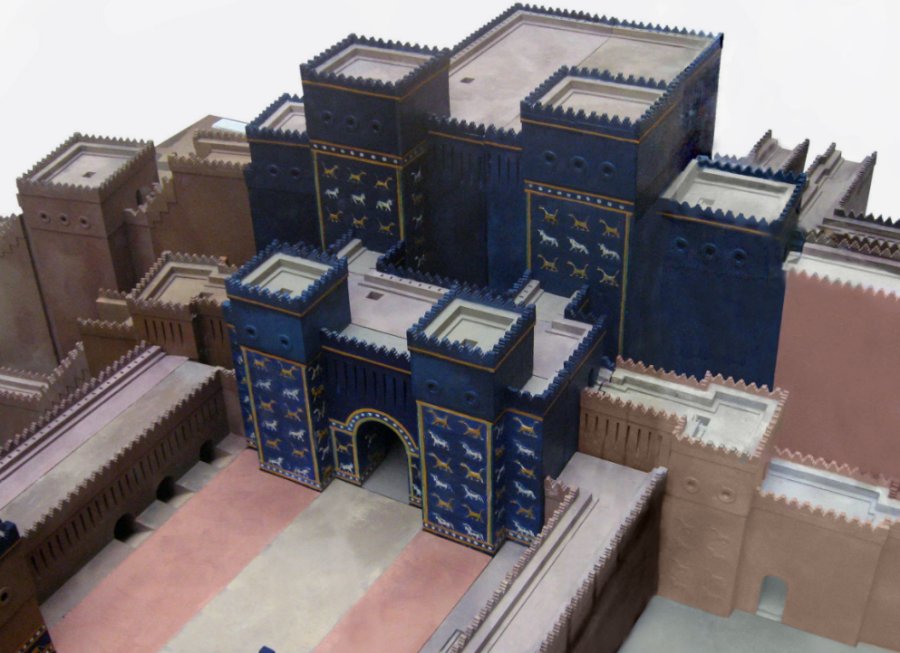Ishtar Gate, The Eighth Gate Of The Inner City Of Babylon
A. Sutherland - AncientPages.com - The Ishtar Gate was constructed by the Babylonian King Nebuchadnezzar II circa 575 BC.
City model of the main procession street (Aj-ibur-shapu) and Ishtar Gate in Babylon. Model at the Pergamonmuseum. Gryffindor - Public Domain
This enormous burnt-brick entryway was located over the main thoroughfare in the ancient city of Babylon (now in Iraq). Built about 575 BC, it became the eighth fortified gate in the city.
The Ishtar Gate was more than 38 feet (12 meters) high and was decorated with glazed brick reliefs, in tiers, of dragons and young bulls.
The gate itself was a double one, and on its south side was a vast antechamber. Through the gatehouse ran a stone- and brick-paved avenue, called the Processional Way, a major road in which burned bricks and carefully shaped stones were laid in bituminous mortar.
It has been traced over a length of more than half a mile.
In his book "Babylon: Mesopotamia and the Birth of Civilization", Paul Kriwaczek, Paul writes:
"Beyond E-Sagila and Etemenanki, visitors to Babylon passed through another gate to enter the adjoining quarter: ‘From the Grand Gate to the Ishtar Gate is called Ka-Dingir-ra’, says the itinerary. Ka-Dingira is Sumerian for the Akkadian Bab-Ilum, Babylon, interpreted as meaning Gate of God; perhaps this area was the original nucleus of the urban foundation.
The reconstruction of the Ishtar Gate in the Pergamon Museum in Berlin. Image credit: Rictor Norton - source - CC BY 2.0
Thus Eridu, the original locus of Mesopotamian culture, and Babylon, its final and most glorious expression were here symbolically united in facts on the ground.
The Ka-Dingir-ra quarter contained the most spectacular of Nebuchadnezzar’s urban-renewal projects: his own magnificent palaces, the processional way, its walls magnificently decorated with glazed-tile lions, leading to the Marduk temple through the magnificent 18-meter-high Ishtar Gate with its crenelated bastions, their glittering blue façades adorned with bulls and dragons in white and ochre, and bearing a long inscription by the king himself:
This street of Babylon had become increasingly lower, I pulled down the gates and re-laid their foundations at the water table with asphalt and bricks.
I had them remade of bricks with blue stone on which wonderful bulls and dragons were depicted. I covered their roofs by laying majestic cedars lengthwise over them. I fixed doors of cedar wood trimmed with bronze in all the gates.
This is the so-called inscription plaque (or building inscription) of the Ishtar Gate appears. The cuneiform inscriptions of the whole text read, "I (Nebuchadnezzar) laid the foundation of the gates down to the groundwater level and had them built out of pure bluestone. Upon the walls in the inner room of the gate are bulls and dragons and thus I magnificently adorned them with luxurious splendor for all mankind to behold in awe." These glazed bricks were found near the main Ishtar Gate during the German excavations of the area, 1902-1914 CE. Neo-Babylonian period, circa 575 BCE. From Babylon, Iraq. Pergamon Museum, Berlin, Germany. Image credit: Osama Shukir Muhammed Amin FRCP(Glasg) - CC BY-SA 4.0
I placed wild bulls and ferocious dragons in the gateways and thus adorned them with luxurious splendor so that Mankind might gaze on them in wonder..."
The sides of the street were decorated with brick lions passant. It has been estimated that there were 120 lions along the street and 575 dragons and bulls, in 13 rows, on the gate.
Not all of these reliefs were visible at the same time, however, for the level of the street was raised more than once; even the lowest rows, which were irregularly laid, may have been treated as foundation deposits.
The site was unearthed by the prominent German archaeologist Robert Koldewey, whose excavation of Babylon lasted from 1899 until 1917. The remnants of the original gate and Processional Way have been housed in Berlin’s Pergamon’s Museum since that institution’s founding in 1930.
Iraq reconstructed the thoroughfare at one of the higher levels but since the 1990s has actively sought the return of the original gate and associated artifacts.
Written by – A. Sutherland AncientPages.com Staff Writer
Copyright © AncientPages.com All rights reserved. This material may not be published, broadcast, rewritten or redistributed in whole or part without the express written permission of AncientPages.com
More From Ancient Pages
-
 On This Day In History: Samurai Final Battle of Shiroyama Was Fought – On Sep 24, 1877
News | Sep 24, 2016
On This Day In History: Samurai Final Battle of Shiroyama Was Fought – On Sep 24, 1877
News | Sep 24, 2016 -
 Apalala: Harsh Dragon Controlling Swat River Who Became Benevolent Naga King Helping People In Buddhist Tradition
Myths & Legends | Jan 26, 2022
Apalala: Harsh Dragon Controlling Swat River Who Became Benevolent Naga King Helping People In Buddhist Tradition
Myths & Legends | Jan 26, 2022 -
 Unexplained Ancient Wars In America – Knowledge Of Ancient High-Tech Weapons? – Part 1
Ancient Mysteries | Sep 29, 2020
Unexplained Ancient Wars In America – Knowledge Of Ancient High-Tech Weapons? – Part 1
Ancient Mysteries | Sep 29, 2020 -
 Rare Medieval Seal Matrix Found By 10-Year-Old Boy In UK
Artifacts | Apr 5, 2022
Rare Medieval Seal Matrix Found By 10-Year-Old Boy In UK
Artifacts | Apr 5, 2022 -
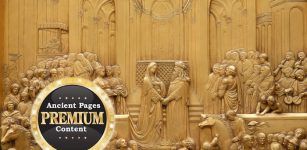 Secret Hidden Freemasonic Messages Concealed In Ancient Egyptian Artifacts And Roman Works – Curious Stellar Symbol – Part 2
Ancient Mysteries | Feb 23, 2022
Secret Hidden Freemasonic Messages Concealed In Ancient Egyptian Artifacts And Roman Works – Curious Stellar Symbol – Part 2
Ancient Mysteries | Feb 23, 2022 -
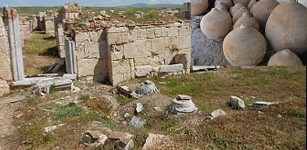 Byzantine Granary With 11 Pithoi Found In Byzantine City Of Amorium In Central Turkey
Archaeology | Aug 5, 2020
Byzantine Granary With 11 Pithoi Found In Byzantine City Of Amorium In Central Turkey
Archaeology | Aug 5, 2020 -
 Maya Storm God Huracán Taught That When We Damage Nature, We Damage Ourselves
Featured Stories | Oct 4, 2024
Maya Storm God Huracán Taught That When We Damage Nature, We Damage Ourselves
Featured Stories | Oct 4, 2024 -
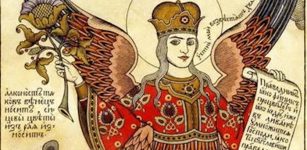 Alkonost – Mythical Bird Of Paradise In Slavic And Russian Folklore
Featured Stories | Jul 6, 2020
Alkonost – Mythical Bird Of Paradise In Slavic And Russian Folklore
Featured Stories | Jul 6, 2020 -
 ‘Impossible’ Ancient Knowledge Of The Gods’ Star – Mysterious Beings – Part 2
Ancient Mysteries | Sep 4, 2021
‘Impossible’ Ancient Knowledge Of The Gods’ Star – Mysterious Beings – Part 2
Ancient Mysteries | Sep 4, 2021 -
 North America’s New Snake Species Deepen Our Understanding Of Reptile Social Behavior And Development
Evolution | Aug 2, 2024
North America’s New Snake Species Deepen Our Understanding Of Reptile Social Behavior And Development
Evolution | Aug 2, 2024 -
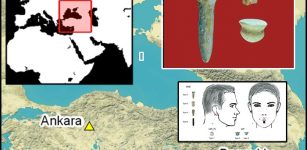 Evidence Of Stone Age Ear and Lip Piercing Found At Boncuklu Tarla Neolithic Site In Türkiye
Archaeology | Mar 14, 2024
Evidence Of Stone Age Ear and Lip Piercing Found At Boncuklu Tarla Neolithic Site In Türkiye
Archaeology | Mar 14, 2024 -
 Secrets Of Legendary Viking Crystal Sunstones And The Mysterious Uunartoq Artifact Unraveled
Artifacts | Jun 3, 2015
Secrets Of Legendary Viking Crystal Sunstones And The Mysterious Uunartoq Artifact Unraveled
Artifacts | Jun 3, 2015 -
 People With Blue Eyes Have One Common Ancestor Who Appeared 10,000 Years Ago
Civilizations | Feb 24, 2017
People With Blue Eyes Have One Common Ancestor Who Appeared 10,000 Years Ago
Civilizations | Feb 24, 2017 -
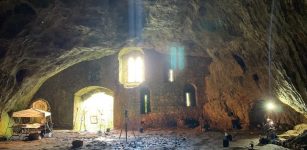 Cave Hidden Under Pembroke Castle in Wales Could Hold Secrets Dating Back 10,000 Years
Archaeology | Jul 16, 2022
Cave Hidden Under Pembroke Castle in Wales Could Hold Secrets Dating Back 10,000 Years
Archaeology | Jul 16, 2022 -
 Ancient Oil Lamp Shop Discovered In Aizanoi, The Second Ephesus
Archaeology | Nov 22, 2021
Ancient Oil Lamp Shop Discovered In Aizanoi, The Second Ephesus
Archaeology | Nov 22, 2021 -
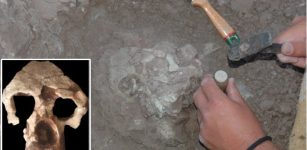 New Fossil Ape Challenges The Story Of Human Evolution
Evolution | Aug 24, 2023
New Fossil Ape Challenges The Story Of Human Evolution
Evolution | Aug 24, 2023 -
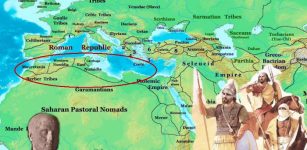 On This Day In History: Emperor Gordian II Loses The Battle Of Carthage – On Apr 12, 238 AD
News | Apr 12, 2016
On This Day In History: Emperor Gordian II Loses The Battle Of Carthage – On Apr 12, 238 AD
News | Apr 12, 2016 -
 Ancient Knowledge Of Other Worlds And An ‘Impossible’ Being That Shouldn’t Exist
Featured Stories | May 6, 2020
Ancient Knowledge Of Other Worlds And An ‘Impossible’ Being That Shouldn’t Exist
Featured Stories | May 6, 2020 -
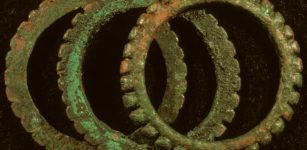 Metal Artifacts In Southeast Asia Archaeological Theory – Challenged
Archaeology | Jul 31, 2021
Metal Artifacts In Southeast Asia Archaeological Theory – Challenged
Archaeology | Jul 31, 2021 -
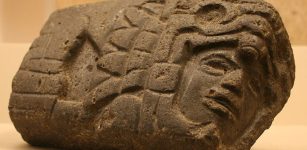 Sociopolitical Organization In Mesoamerica Influenced Developed Writing Systems And Communication
Archaeology | Feb 16, 2022
Sociopolitical Organization In Mesoamerica Influenced Developed Writing Systems And Communication
Archaeology | Feb 16, 2022

